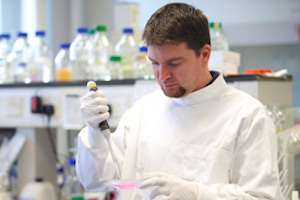Could sticky cells cause drug resistance in chronic blood cancer?

(Medical Xpress)—Chronic myeloid leukaemia (CML) is associated with a specific genetic mutation that results from DNA on different chromosomes breaking off and swapping places. This disrupts genes at the breakpoint and the rejoining point. One of these disrupted genes is called BCR-ABL and drugs that target this mutation have transformed the treatment of CML. However, patients can develop resistance to these drugs, which causes their cancer to return.
Now scientists from The University of Manchester – part of the Manchester Cancer Research Centre - have measured the levels of the BCR-ABL genetic mutation in a cell model of CML. In particular, they separated cells into those that stuck to plastic – "sticky", or adherent, cells – and those non-adherent ones that did not, and looked for differences between the two groups of cells.
Dr Richard Byers, who jointly led the research, said: "Previous studies have linked high levels of the BCR-ABL mutation with drug resistance. We wanted to see how expression of BCR-ABL differed across groups of CML cells, and in particular whether there were differences between adherent and non-adherent populations."
In a study recently published in the journal Experimental Haematology, the group demonstrate that is wide variation in BCR-ABL expression levels in the cell model and the stickier cells have a higher level of BCR-ABL expression. These stickier cells were less sensitive to treatment with a BCR-ABL targeted drug, imatinib.
Dr Byers said: "The small number of cells that show high levels of BCR-ABL may not be detectable through bulk analysis of large samples.
"It looks like it is important to look at protein levels in single cells. In future, it may be possible to measure BCR-ABL levels in individual cells in the clinic – this will help us identify the resistant high BCR-ABL cells and better understand how patients develop resistance to imatinib treatment with the aim of combatting this resistance to make response more durable and the treatment more effective."
More information: Ehsan Ghayoor Karimiani, Fiona Marriage, Anita J. Merritt, John Burthem, Richard John Byers, Philip J.R. Day, "Single-cell analysis of K562 cells: An imatinib-resistant subpopulation is adherent and has upregulated expression of BCR-ABL mRNA and protein," Experimental Hematology, Available online 20 November 2013, ISSN 0301-472X, dx.doi.org/10.1016/j.exphem.2013.11.006.














